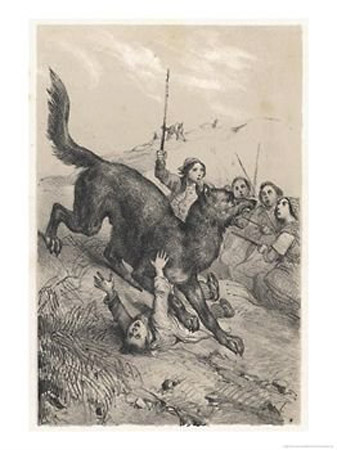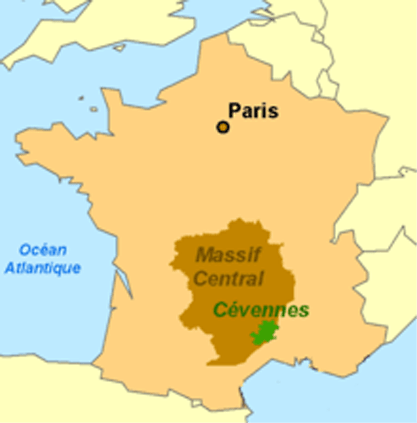From 1809-1817, the Beast of the Cévennes, the Beast of the Gard or the Beast of Vivarais,(a creature which obviously ranged far and wide) was just one more in the long, long series of creatures, beasts, monsters, feral or hybrid dogs, wolves with completely atypical behaviour or sexual psychopath serial killers who have ravaged different areas of France from around 1550 until the present day. Here is the Cévennes region:
Here is the Vivarais area, in red, in the centre:
And here is the Gard area, famous for the Pont du Gard. Again, it is in red:
Once again, I have looked at a number of French cryptozoological websites and you can take your own average between them. “Vampire Dark News” provides a solid, simple introduction to the latest killer:
“This particular creature spread panic in a vast region comprising Lozère, the Grand Gard and the Ardèche from 1809-1817. It killed, however, comparatively few victims compared to the eight long years when it was active. There were only 29 victims, almost exclusively women and children, six of whom were decapitated. On the other hand, the monster was brave enough to venture into the very houses where people lived. Their descriptions said that the beast was a wolf the size of a donkey with brown fur, a black mane and large udders. Perhaps it was an animal which had escaped from a circus. This creature was never killed.”
(My own translation)
How many wolves fit that description? A black mane? The size of a donkey? Large udders?
The French version of Wikipedia, provides a slightly more developed tale. It begins with the story of how :
« The Journal du Gard on Octobre 21st 1809 announced the attacks by this animal in these terms :
« In just a few days, a ferocious animal has spread terror in the region of the Gard. Just like the Beast of Gévaudan of days long past (1764-1767), the Beast of the Cévennes is ravaging this part of the “country.”
 Wikipédia then goes on to say:
Wikipédia then goes on to say:
“The Beast killed 29 people, including 19 children, but the list might actually be longer, because the Death Certificates do not always mention the reason for the death. A child called François Marcy, seven years old, was devoured on September 8th 1812 next to his house. Augustin Colomb, aged eight, was carried off on January 9th 1813. Only his head was ever found. In the middle of October, little Rose Henriette Dumas, aged seven, was devoured in the woods. The attacks went on from 1809-1816, and the audacity of the creature recalls the famous affair of the Beast of Gévaudan. A woman of 34 was attacked just coming out of the church and the beast even attacked villagers inside their own houses. The rumour was current that it had even eaten the hands of a child who was being rocked in his cradle. Despite numerous beats and traps set by the people of the different villages the creature remained uncatchable. The attacks came to a final end in 1816 but the affair was never cleared up. It is unknown if this animal was killed during a beat, whether it changed its area of operation or if it was a question of crimes which had been carried out by human beings but were then disguised as being the work of a monster.
Several theories are offered about the origin of this aggressive animal. According to certain people it was a female wolf from Spain even though its behaviour did not resemble that of a wolf in any way whatsoever. The pins in the clothing of certain of his female victims had been removed (hardly the behaviour of a wolf) and six corpses were found decapitated, their necks seemingly having been cut by a blade. The very act of decapitation, of course, is not one which is done deliberately by any animal.Mont Lozère seems to have been the epicentre of the whole business and had already experienced widespread attacks by wolves in the seventeenth century.
The descriptions which were given by witnesses at the time are extremely variable. Some people talk of an immense wolf, the size of a donkey with a mane and a coat of brown or red fur. Other witnesses describe a creature, or a wolf, the size of a calf, with a grey and red coat. In the majority of the descriptions, the witnesses agree on the presence of a huge belly covered in white fur which almost dragged on the ground. The beast had large ears, a long muzzle and a thick, heavy, tail.”
(My own translation)
What animal was this? An immense wolf, the size of a donkey with a mane and a coat of brown or red fur? A wolf the size of a calf ? A huge belly covered in white fur almost dragging on the ground? A creature, or a wolf? This is beginning not to make any sense at all. The French peasants in this area, just like those in Gévaudan, all knew a wolf when they saw one. And white fur underneath its body means it cannot have been any species of wolf known today. And the Beast of Gévaudan explanation, based on crazed killers who used hybrid creatures to kill on their own perverted and vengeful behalf will only stretch so far. Indeed, the more I think about it, the more I am beginning to have my doubts even about Jean or Antoine Chastel and the rest of the local lunatics who were supposed to have masterminded the Gévaudan outrages.
Another website relates how :
“The Beast of Vivarais (or of Cévennes) killed many women and children between 1809 and 1817 within the departments of Lozère, Gard and Ardèche. The animal is described as having the form of a wolf, but with longer ears and black hair bristling over the entire length of its back. Another report, dating from 1813, speaks of a wolf the size of a calf, with grey and red fur, with a dangling belly covered in white fur with “roudeaux” (a word I have been unable to find in any dictionary, but they are tabby or tiger striped with white). The head and muzzle are long, the tail is long and sticks up at the end. The official number of victims is twenty-nine. However it is likely that the list is actually longer because Death Certificates do not necessarily mention the cause of death. In an article on the Beast of the Cevennes, Guy Crouzet details all of these killings, some of which say a great deal about the horror and helplessness of the local people in trying to overcome events which had left them completely out of their depth. And so near the village of Brahic: “was interred the body of François Marcy of Vénissac, seven years old, eaten by a wild beast on September 8th 1812, just a few steps from his home. Vézian, minister of the church.”
“ January 9th, 1813, the death of Augustine Columbus, aged eight. Devoured by a wolf, only the head was found. The boy was abducted on January 8th at five o’clock in the evening in the place called Beaujeu.”
On October 23rd 1813 at Saint-André-de-Cruzières, before the authorities there appeared: “Jacques Dumas, a farmer by profession, the uncle of the deceased, who lived in Chazelles and also Monsieur Graffand the Imperial Solicitor, who lived in Pierregras. They stated that Rose Henriette Dumas, seven years old, the daughter of Louis Dumas, a builder and Marie Maurin, from Chazelles has died from having been devoured in the woods by a ferocious wild beast yesterday, October 22nd, The remaining fragments of the deceased’s body were collected up, inspected carefully and then wrapped in the blood soaked skin of the little girl. They were recognized by her father Monsieur Dumas to be those of his late daughter Rose Henriette.”
Guy Crouzet also made a good point about Mont Lozère, which seems to have been the focus point of the Beast’s activities. Mont Lozère has already played host in the past to other monsters of the same type: in the seventeenth century, attacks by wolves on human beings were reported in the region of Saint-Julien-du-Tournel. And don’t forget that that the very first attacks by the Beast of Gévaudan were reported in Langogne, on the very edge of the Vivarais region. The Beast of Vivarais finally disappeared from the region in 1817, without ever being found. Perhaps it was killed during one of the many organized beats. Nobody knows.
(My own translation)
A wolf, but with longer ears and black hair bristling over the entire length of its back?? A wolf the size of a calf, with grey and red fur?? A dangling belly covered in white fur?? A tail that is long and sticks up at the end? For a wolf?
The “Midnight Forum” possibly isn’t quite the kind of website you might have expected, but it provides many of the details we have previously noted:
“The Beast of the Vivarais was also known as the Beast of the Cévennes or the Beast of the Gard, This monster killed 19 children. This creature first appeared in the regions of Ardèche and Gard in 1809. The descriptions of the monster vary widely. Some say it was a huge wolf the size of a donkey, with a thick mane and a coat of brown or red fur. Others said that the creature was completely black, or that it was a wolf the size of a calf with a grey and red coat. In most descriptions, however, witnesses spoke of a big belly covered in white fur, which hung almost to the ground. Many thought it was a she-wolf that could have come from Spain, even if the behaviour of the animal was in no way whatsoever like that of a wolf. It had big ears, with a long snout and a luxuriant tail.”
(My own translation)
This last one may well be a rehash of other accounts, but it is equally possible that it may be the firstborn account which all the others have rehashed.
Nobody could accept without question that this animal was an everyday, common or garden wolf. These French people two hundred years ago knew wolves.
From 1818-1829, supposedly 14,000 wolves were killed every single year in France. Even in 1889, around 500 wolves were trapped or shot nationally. The last wolf was killed as recently as 1937. It is, of course, a different question to explain exactly what the Beast of the Cévennes, the Beast of the Gard or the Beast of Vivarais may have been. And at this distance in time, it is not really very likely to happen. Having said that, I am working on it, even as we speak….







